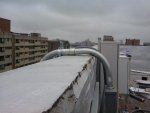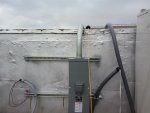Here are a few more pics which might help explain how and why I did it this way.




The left pic obviously shows the C-bodies, which are perched on the face of the bump-out. They're there because of the bends in the run:
Starting at the top, there are 90's pointing down toward the roof where the conduits pass over the top the 5'-tall outer wall, 45's where the conduits pass around the 4'-wide overhang, 90's around that overhang, and 45's where those return to the wall to point downward. The offsets bring the total to 360 degrees, but toting the conductors to the roof and pulling downward made the pull almost effortless.
Below the C-bodies, there is the second pair of offsets and the 90's in the old conduits where they turn horizontal against the basement ceiling. At this point, the power and ground-bearing conduits part company. The power conduit has one 90 in the basement where it turns toward the meter stack (perpendicular to the outside wall), and one more 90 where the conduit turns down into the top of the meter stack.
The conduit with the ground conductor reduces down to 1-1/4" EMT, has another offset and one more C-body, then continues toward the center of the basement with a couple of more bends, and terminates at the building's main water pipe. Of course, the grounding conductor is bonded to the conduit at both ends with bonding bushings, as is the EGC run with the power conductors. Everything is copper per the specs.
I started by assembling the 45's, the 90's, and the 45's at the top and clamping them to the wall. Then I passed a nylon rope with a hook attached (see left pic above) through the assemblies, where helper #1 passed them through each section of pipe and hooked them to the bottom end, I pulled each on up from the roof, and helper #2 screwed it onto the pipe above, and installed one or two strut clamps.
This method worked well because helper #2 didn't have to support the weight of each section of conduit while screwing it to the one above, and each pull was shorter than the previous one as we grew more tired. We alternated left and right so we didn't have to work our way down twice, and it was easier to do the cutting-and-threading work (the final pipe connections) near ground level instead of 90+ feet in the air.
The pulls were so easy, one getting the tips of the wires past the bends at the top, that we didn't even need to use the C-bodies for the pulling. In fact, we had to fight gravity near the finish, and I installed wedges to minimize the pull of the weight of the wire on the terminations. And, yes, we did attach the conduits and the disconnect to the face of the wall with strut and hardware before we were done.




